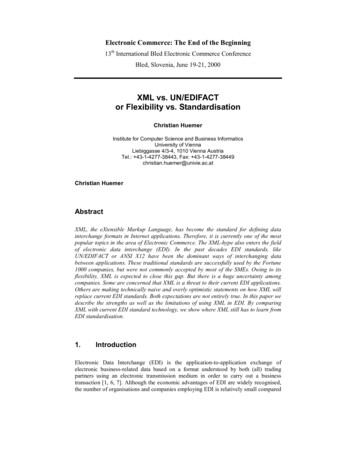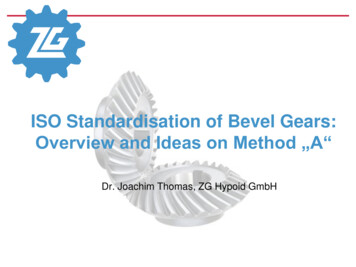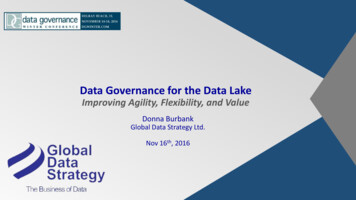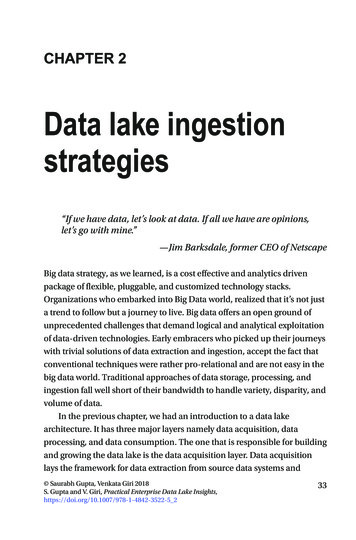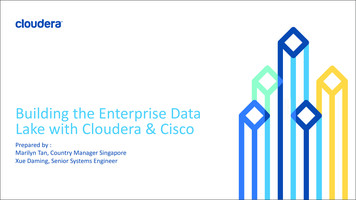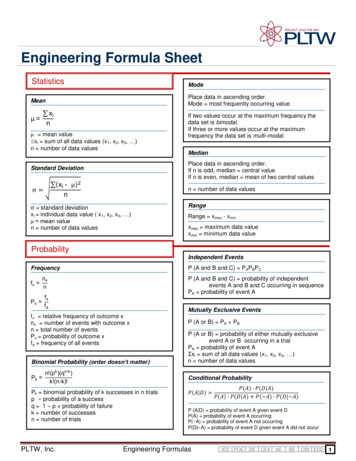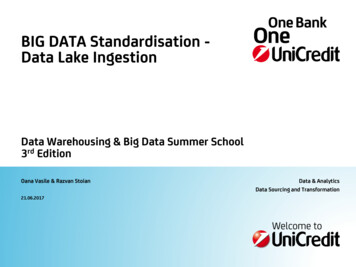
Transcription
BIG DATA Standardisation Data Lake IngestionData Warehousing & Big Data Summer School3rd EditionOana Vasile & Razvan Stoian21.06.2017Data & AnalyticsData Sourcing and Transformation
Content Big Data Introduction ETL Process Overview – IBM DataStage Study Case: UBIS Implementation2
Content Big Data Introduction Big Data Definition From Data Warehouse to Data Lake HDFS – Reliable storage Cloudera Hadoop Distribution Data files on Hadoop SQL-like querying: HIVE and Impala ETL Process Overview – IBM DataStage Study Case: UBIS Implementation3
Big Data DefinitionBerkeley study: top recurring themes in our thought leaders’ definitions4
Big Data Definition: the Vs5
From Data Warehouse to Data Lake Historically, analytics and business intelligence workloads are done using a data warehouse, a technologythat IT departments have tried to make a central data repository. Data warehouses and databases, by their very nature, are too expensive and too constrained by storageand performance to put all of your data in one place. Storage options built on cheap commodity hardware such as the Hadoop Distributed File System offereda different approach that was sorely needed as businesses sought to leverage more data and morecomplex data than ever before. Data Lakes or data hubs storage repositories and processing systems that can ingest data withoutcompromising the data structure -- have become synonymous with modern data architecture and big datamanagement. The resulting data lake has a major benefit: The lack of a data structure gives data scientists a chance to analyze the data without apredetermined schema and companies can move away from the rigid structure-ingest-analyzeprocess to a more flexible ingest-analyze-understand process.6
HDFS – Reliable storage Hadoop includes a fault‐tolerant storage system called the Hadoop Distributed File System. HDFS is ableto store huge amounts of information, scale up incrementally and survive the failure of significant parts ofthe storage infrastructure without losing data. Hadoop creates clusters of machines and coordinates work among them. Clusters can be built withinexpensive computers. If one fails, Hadoop continues to operate the cluster without losing data orinterrupting work, by shifting work to the remaining machines in the cluster. HDFS manages storage on the clusterby breaking incoming files into pieces,called blocks and storing each of theblocks redundantly across the pool ofservers. In the common case, HDFSstores three complete copies of eachfile by copying each piece to threedifferent servers.7
Cloudera Hadoop Distribution Cloudera distribution including Apache Hadoop provides an analytics platform and the latest open sourcetechnologies to store, process, discover, model and serve large amounts of data. Hadoop is an ecosystem of open source components that fundamentally changes the way enterprisesstore, process, and analyze data. Unlike traditional systems, Hadoop enables multiple types of analyticworkloads to run on the same data, at the same time, at massive scale on industry-standard hardware. By integrating Hadoop with more than a dozen other critical open source projects, Cloudera has created afunctionally advanced system that helps you perform end-to-end Big Data workflows.8
Cloudera Hadoop Distribution CDH combines storage and computation into a single, scalable system and delivers the flexibility andeconomics required to perform operations on big data that are not possible with traditional solutions dueto time or cost. Advantages: Unify storage and computation within a single set of system resources Store data in any format, free from rigid schemas Bring a diverse array of analytic frameworks to a single pool of data—including batch processing,analytic SQL, interactive search, machine learning, stream processing, and a variety of 3rd partyapplications Process data in parallel and in place with linear scalability Deliver data in real-time to users and applications Integrate with your existing data management and analysis tools9
Data files on Hadoop Choosing an appropriate file format can have some significant benefits: Faster read times Faster write times Splittable files (so you don’t need to read the whole file, just a part of it) Schema evolution support (allowing you to change the fields in a dataset) storage economy (type of file and compression)HOW TO CHOOSE A DATA FORMAT? Choosing a data format is not always black and white, it will depend on several characteristics including: Size and characteristics of the data Project infrastructure Use case scenarios10
Data files on HadoopPlain text storage (eg, CSV, TSV files) Text files are human readable and easily parsableText files are slow to read and write.Data size is relatively bulky and not as efficient to query.No metadata is stored in the text files so we need to knowhow the structure of the fields. Text files are not splittable after compression Limited support for schema evolution: new fieldscan only be appended at the end of the records andexisting fields can never be removed.JSON (JavaScript Object Notation) designed for human-readable data interchange.easy to read and write.lightweight text-based interchange format.language independent.Sequence Files 11Row-basedMore compact than text filesYou can’t perform specified key editing, adding, removal: files are append onlyEncapsulated into the Hadoop environmentSupport splitting even when the data inside the file is compressedThe sequence file reader will read until a sync marker is reached ensuring that a record is read as a wholeSequence files do not store metadata, so the only schema evolution option is appending new fields*) Image and video files have are not treated here and are managed in a particular way (e.g.: leveraging on HIPI ImageBundle framework)
Data files on HadoopAVRO Columnar File Formats (Parquet)Row-basedDirect mapping from/to JSONInteroperability: can serialize into Avro/Binary or Avro/JsonProvides rich data structuresMap keys can only be strings (could be seen as a limitation)Compact binary formExtensible schema languageUntagged dataBindings for a wide variety of programming languagesDynamic typingProvides a remote procedure callSupports block compressionAvro files are splittableBest compatibility for evolving data schemasORC files Row-based More compact than text files You can’t perform specified key editing, adding, removal: files areappend only Encapsulated into the Hadoop environment12 Column-oriented Efficient in terms of disk I/O and memoryutilization Efficiently encoding of nested structures and sparselypopulated data. Provides extensible support for per-column encodings. Provides extensibility of storing multiple types of data incolumn data. Offers better write performance by storing metadata at theend of the file. Records in columns are homogeneous so it’s easier to applyencoding schemes. Parquet supports Avro files via object model converters thatmap an external object model to Parquet’s internal data types Support splitting even when the data inside the file is compressed The sequence file reader will read until a sync marker is reachedensuring that a record is read as a whole Sequence files do not store metadata, so the only schema evolutionoption is appending new fields
SQL-like querying: HIVE and Impala Apache Hive introduced by Facebook to manage and process the large datasets in the distributed storage is an abstraction on Hadoop MapReduce and has its own SQL like language – HiveQL it’s a great interface for anyone coming from the relational database world: to use it, you set upstructured tables that describe your input and output, issue load commands to ingest your files, andthen write your queries as you would in any other relational database Limitation: provided a familiar and powerful query mechanism for Hadoop users, but query responsetimes are often unacceptable due to Hive’s reliance on MapReduce Cloudera Impala seeks to improve interactive query response time for Hadoop users extension to Apache Hadoop, providing a very high-performance alternative to the Hive-on-top-ofMapReduce model13
Content Big Data Introduction ETL Introduction IBM Datastage Datastage Runtime Architecture on Hadoop Study Case: UBIS Implementation14
IBM DataStage15
DataStage clients Designer create DataStage jobs Director run and monitor jobs Administrator configure DataStage projects administer execution environments16
DataStage : Jobs Parallel jobs executable program development steps: import metadata into the Repository build job in Designer using stages and links compile job in Designer : generates OSH code run and monitor job execution in Director Job Sequences master controlling job that controls the execution of a set of subordinate jobs passes values to the subordinate job parameters controls the order of execution specifies conditions under which the subordinate jobs get executed17
DataStage : Most used stages File Sequential file Data Set SAS Database ODBC Oracle Teradata Processing Sort Remove Duplicates Transformer Aggregator Filter Copy Funnel Join, Lookup, Merge18
IBM DataStage on Hadoop In release 11.5, Information Server can execute directly inside a Hadoop cluster. This means that all of thedata connectivity, transformation, cleansing, enhancement, and data delivery features that thousands ofenterprises have relied on for years, can be immediately available to run within the Hadoop platform To use the functionality on Hadoop, the engine tier is installed on a Hadoop edge node in a Hadoop cluster.The product is configured to send jobs to the InfoSphere Information Server engine tier in Hadoop so thatthe jobs will run on the Hadoop cluster. The engine tier node communicates with YARN to run a job on the compute nodes on a Hadoop cluster. Stages for Big Data processing Big Data File : enables InfoSphere DataStage to exchange data with Hadoop File Connector : write/read AVRO files on Hadoop HIVE Connector : access HIVE database19
YARN – Datastage Runtime Architecture on HadoopApache Hadoop YARN is the framework for job scheduling and cluster resource management.Information Server can communicate with YARN to run a job on the data nodes on a Hadoop cluster in thefollowing way:20
Content Study Case: UBIS Implementation 21Data Lake StructureTechnical Architecture Overview/FrameworkTechnical Metadata RepositoryDataStage processFile compressionSecurity : Protegrity and KerberosProcess Logging with Splunk
Data Lake StructureSPEED LAYERReal Time Raw Events, Transformed EventsMainframeRDBMSWeb ServicesData QuesRaw Data PoolAS-IS File Storageon HDFSIncremental andOne-time sourcesSPOOLTemp AS-IS FileStorage on Local DSFlat FilesSource Image PoolFileManagementpoliciesData RetentionPoliciesTECHNICALAREAConversion to ASCIISOURCESCONSUMER LAYERSTAGING AREAData RetentionData Structured toSupport Agile Usageand NavigationSHARED LAYERData SynchronizedData ValidationSecured DataREPARTITIONED AREABusiness Driven ModelFull Business EntitiesRepresentation withLifecycleLAB LAYERUser data, Team / Project data / Data Science22Lifecycle Based onPurposedData Organized forQueries PerformancePRESENTATION AND ANALYTICSRAW LAYERLANDING AREA
Data Lake Structure: Focus on Batch IngestionRedesigned to keep 1:1 imagewith Source and introduced filemanagement policiesNew: Redefined folderstructure and reloadmanagementRAW LAYERMainframeFlat FilesSource Image PoolRaw Data PoolAS-IS File Storageon HDFSIncremental andOne-time sourcesWeb ServicesData QuesTemp AS-IS FileStorage on Local DSSPOOLRDBMSTemporary layeracting as securedbuffer for pusheddata23STAGING AREAFileManagementpoliciesData RetentionPoliciesTECHNICALAREAConversion to ASCIISOURCESLANDING AREAData RetentionData ValidationSecured DataREPARTITIONED AREATechnical buffer forconversion to ASCII onlyNew area to improveConsumer Layerprocessing performance* Current architecture designed for flat files, Mainframe files., RDBMS is WiP, Data Ques and WebServices have successful POCs
Technical Architecture Overview/Framework dedicated CA application for eachCAsource filescheduler time and/or event triggeredShellscript generic script used to start DSflow with specific parametersServer cture generic job used to start ingestionflow with parameters fromMetadata RepositoryDSSequence create folder structure on cluster copy file from spool to landing Logging architecture for processmonitoring mappingATOM job rejectmanagement24ClouderaHadoop
DS Standard Implementation Process for Raw Layer (roles)1. Analyst compiles a standard excel file with: information from analysis of source files mapping definition from source file to raw layer file and data quality check definition of source structure to be used2. Developer 25get parameters from excel file and insert them into metadata tablerun setup script to initialize environmentdevelop mapping job (ATOM)run mapping job/sequence by DS client or startup script
Technical Metadata Repository An ORACLE database will be used to store the technical metadata – parameters needed to run the loadingprocess The metadata model includes: CBD RL ACQUISITION – operational table with information for Raw Layer Acquisition process contains Raw Layer file register and information needed to manage the file from Spool to STG used by Server job, JS RunIngestionProc, to retrieve input parameters and start the IngestionSequence CBD RL ACQUISITION H – history table keep track of changes on parameter values used to rerun processes with older configurations CBD DS CFG APT – Datastage APT configuration lookup table CBD DS CFG APT YARN – Datstage APT YARN configuration lookup tableThey contain the possible values for APT files to be used running Datastage sequence and jobs –available for tuning operations26
Technical Metadata Server job gets information from the Metadata Repository starts the run of the Sequence that controls the loading process Input parameters to be provided at runtime: RL FILE NAME RL ORGANIZATION SNAPSHOT DATE SPOOL FILENAME - optional VALIDITY DATE - optional27
Server Job DS Sequence SPOOLCopy filefrom SPOOLto LANDING ASCIISRClocationSRCencoding LANDINGHIVEFlag28RunJx LandingToSTG EBCDIC YESDrop partition foractual SNAPSHOT datefrom HIVE target anderror tablesRunJx LandingToTAAdd new partition inHIVE target and errortablesRunJx TAToSTG
RECAP: Technical Architecture Overview/Framework(NEXT: ATOM JOB) dedicated CA application for eachCAsource filescheduler time and/or event triggeredShellscript generic script used to start DSflow with specific parametersServer cture generic job used to start ingestionflow with parameters fromMetadata RepositoryDSSequence create folder structure on cluster copy file from spool to landing Logging architecture for processmonitoring mappingATOM job rejectmanagement29ClouderaHadoop
DS Sequence Atom (ASCII vs EBCDIC templates) different prototypes depending on encoding of source files and DQ checksUK definedJX TAToSTG EBCDIC filename TEMPLATE UKcheckEBCDICNo UK definedJX LandingToTA EBCDIC filename TEMPLATEJX TAToSTG EBCDIC filename TEMPLATEInput fileUK definedJX LandingToSTG ASCII filename TEMPLATE UKcheckNo UK definedJX LandingToSTG ASCII filename TEMPLATEASCII30JX LandingToTA EBCDIC filename TEMPLATE
Atom: Syntactic DQ checks on input dataSourcedataDQ CHECKS Non numeric contentin a numeric field Decimal content notcompliant withdeclared precisionand scale Non date content in adate field Date content notcompliant withdeclared format Violation of adeclared UK31 Check data formatcompliancy andreject bad recordsLoadingprocessRejectprocessStagingarea Only correctrows loaded intoSTG AVRO file
ATOM for EBCDIC fileLanding to TA For each EBCDIC file, two steps needed: conversion from EBCDIC to ASCII and store file temporary in Technical Area perform DQ checks and write target AVRO file in Staging area Landing file : specific table definition loaded from CopyCOBOL - EGDIVICT.CopyCOBOL TA file : table definition with all fields defined as VarChar - EGDIVICT.AllVarChar32
ATOM for EBCDIC fileTA to STG only with syntactic DQ checks TA file: table definitionwith expected datatypes, to performsyntactic DQ checks – EGDIVICT.DQ STG file: table definitionwith DS AVROcorrespondent datatypes – EGDIVICT.DSAvro Reject file: tabledefinition with all fieldsstring and additionalErrorMessage column tostore rejection reason – EGDIVICT.AllVarChar33
ATOM for EBCDIC fileTA to STG with additional UK violation check Xmer MappingSort input data by UKImplements LoopCondition to countnumber of records withthe same value of theUKUses constraint to filterout on lnkRJCT UK,lines with duplicatedUK value Funnel RJCTUnion between rejectsfrom data type checkand UK check34
ATOM for ASCII filesLanding to STG only with syntactic DQ checks35
ATOM for ASCII filesLanding to STG with additional UK violation check36
Repartitioning processAcquisitionparametersServer Job fordefaultpartitioningServer Job forfunctional partitioningcreating the query toextract partitioningvaluesPartitioningparameters37Sequence fordefaultpartitioning(snapshot date)PX Job to extractpartitioning valueswith the created queryATOM MappingjobREPARTITIONINGMapping job withwhere condition'partition key value'Sequence forfunctional partitioningLoop for eachdistinct value
RECAP: Technical Architecture Overview/Framework dedicated CA application for eachCAsource filescheduler time and/or event triggeredShellscript generic script used to start DSflow with specific parametersServer cture generic job used to start ingestionflow with parameters fromMetadata RepositoryDSSequence create folder structure on cluster copy file from spool to landing Logging architecture for processmonitoring mappingATOM job rejectmanagement38ClouderaHadoop
Target structure : AVRO files AVRO schemaTwo AVRO schemas are needed: ADF0BDA0 ATTGAR.avsc– for target AVRO file (real data types)ADF0BDA0 ATTGAR e.avsc – for reject AVRO file (all columns defined asstring and one additional column for DSErrorMessage){"type": "record","name": "ATTGAR","fields": [{"name":"CORA BANCA","type":["long","null"]},{"name":"CORA NDG","type":["string","null"]},{"name":"CORA PROG GAR","type":["long","null"]},{"name":"CORA ATTRIBUTO GAR","type":["long","null"]},{"name":"CORA VALORE ATT GAR","type":["string","null"]},{"name":"CORA DATA ELAB","type":["long","null"]}]}39{"type": "record","name": "ATTGAR e","fields": [{"name":"CORA BANCA","type":["string","null"]},{"name":"CORA NDG","type":["string","null"]},{"name":"CORA PROG GAR","type":["string","null"]},{"name":"CORA ATTRIBUTO GAR","type":["string","null"]},{"name":"CORA VALORE ATT GAR","type":["string","null"]},{"name":"CORA DATA ssage","type":["string","null"]}]}
Target structure : AVRO file Check data inside AVRO filehadoop jar /opt/cloudera/parcels/CDH/lib/avro/avro-tools.jar tojson filepath / filename 40
Target structure : HIVE table connect to HIVE : beeline –u connection string 41
Target structure : HIVE table42
File compression File compression brings two major benefits:1. it reduces the space needed to store files2. it speeds up data transfer across the network or to or from disk. Compression formats: gzip, bzip2, LZO, Snappy Reasons to compress: Data is mostly stored and not frequently processed. It is usual DWH scenario Compression factor is very high and thereof we save a lot of I/O. Decompression is very fast (l
the jobs will run on the Hadoop cluster. The engine tier node communicates with YARN to run a job on the compute nodes on a Hadoop cluster. Stages for Big Data processing Big Data File: enables InfoSphere DataStage to exchange data with Hadoop File Connector : write/read AVRO files on Hadoop
